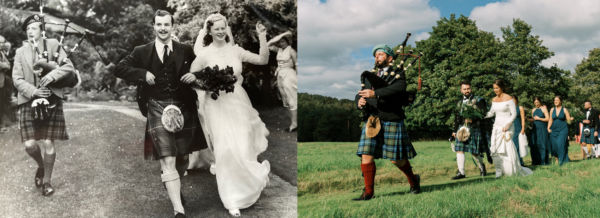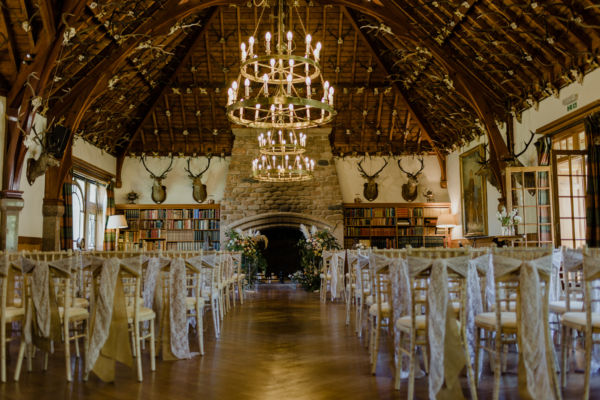
If you happen to have attended a wedding recently – whether as a guest, bride or groom – chances are it will have taken place in one, exclusive-use venue. But for those of us who can remember a few decades back, that style of wedding used to be the exception, rather than the rule.
In 1990s Aberdeenshire, it was Glen Tanar that decided to be innovative, and create a wedding option more similar to those we know today. The driving force behind that was our Director, Claire Bruce.
Given that weddings provide us with a snapshot in time of fashion and social conventions, we knew you’d be interested to hear about what galvanised Claire into making Glen Tanar Aberdeenshire’s most enduring destination wedding venue and to uncover some of the changes in style she’s witnessed over the past 30 years…
" When I came to live at Glen Tanar in the late 80s, I could instantly see what an incredible asset to the estate our beautiful ballroom is. Originally built as a music room in the 1870s, it’s played host to some very special events for well over 150 years (sometimes with the royal family in attendance), but very rarely a wedding. In fact, the only one we have a record of is my late mother-in-law’s wedding, which took place in 1950 in both the chapel of St Lesmo and the ballroom and from which I most definitely drew inspiration."

“That, in addition to helping my mother-in-law organise other ballroom events and seeing the potential it had 40 years later underlined my instinct that Glen Tanar would make the most stunning wedding venue."
Claire Bruce, Director, Glen Tanar Estate

“ As it happened, the first wedding we undertook was by request of a local Aboyne family, in 1990. Before we did so, however, I felt I needed to get myself some intensive events experience, and spent some time working for a London-based events company. During this invaluable experience, I was immersed in every aspect of an event, from the washing up to the set-up and from the catering to financial management. I came back to Glen Tanar armed with knowledge and full of enthusiasm for that first wedding. "

“ And we didn’t look back. From that day, I managed all the weddings we held for many years, with our diary filling up simply by word of mouth. A wedding in one country location, in a stunning ballroom with outstanding gardens and with a gem of a Victorian chapel on site; that was something very unusual in the 1990s. By offering the accommodation that was requested more and more, in the form of seven luxury cottages, we have added to our reputation as an exclusive Highland wedding destination. And whilst the concept is no longer as unusual as it was, we still offer a truly unique, year-round wedding experience of which I am very proud.

Critical to that experience has been the development of our relationship with the very best local suppliers and that continues to be central to all that we do. What has changed, however, are styles and formats of weddings over the past 30 years… "
Claire Bruce, Director, Glen Tanar Estate
Who Takes Control?
In the 1990s and 2000s, the wedding couple’s parents – in particular the bride’s parents – were heavily involved in all planning, and much of the cost too. That has changed dramatically, not least because couples are far more likely to contribute to – or be entirely responsible for – the cost of their own wedding. Of course, parents continue to play an important role in a wedding, but that role has shifted over time.
Keeping it Intimate
Large weddings were de rigueur in decades past. Our ballroom holds up to 160 – we were often asked to accommodate up to 200. Nowadays, much smaller, intimate weddings are the norm. Why has that change taken place? Firstly, weddings are a more expensive process than ever before, but equally, there has been a shift towards more individual, themed celebrations which can move away entirely from the “traditional formula”, in keeping with developing styles, access to online inspiration and the fact that in the UK, we are lucky enough to live in a country which celebrates all marriages.
Chapel or No Chapel?
Another significant change has been the reduction in numbers of those who wish to marry in our chapel, before returning to the Ballroom for the reception. Whilst this reflects a society less inclined to church attendance, it is also the result in a change in Scottish legislation, which allows religious wedding ceremonies to be carried out in any location.

What’s Next?
We also caught up with Aoibhinn Martin, Events Co-ordinator and first port of call for anyone considering a Glen Tanar wedding. With three – as opposed to 30 - years at Glen Tanar under her belt, we asked her what it’s like to be responsible for so many couples’ dream day in the 2020s…
“I joined Glen Tanar at the height of the pandemic, when guidance on weddings could change on an almost daily basis. However, that challenge did not throw us off our stride and I think we can safely say we’re an incredibly flexible outfit! Now that things are thankfully back to normal, I’ve been reflecting on some of the great weddings we’ve hosted over the past three years and for me, it’s the individuality of each that really stands out. I’m so intrigued to hear Claire talking about the popularity in the 90s/2000s of a more formulaic wedding – I don’t think I’ve planned a wedding so far that hasn’t had a specific theme, individual to that couple. However, fashion always goes full circle, so who knows – we may see a return to the trends of the 90s in due course. "

“ For now, though, the effort and imagination that goes into each wedding is incredible - from the books and library themed wedding we recently organised, to the bride who grew her own flowers, each wedding is an investment and the culmination of so much planning and it’s really a privilege to help bring our couples’ ideas to life. Fashions come and fashions go, but that is exactly what Claire envisaged 30 years ago and we wouldn’t have it any other way. ”
Aoibhinn Martin - Events Co-ordinator